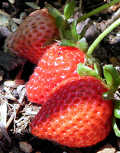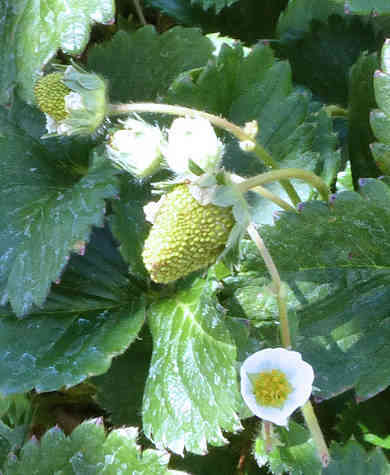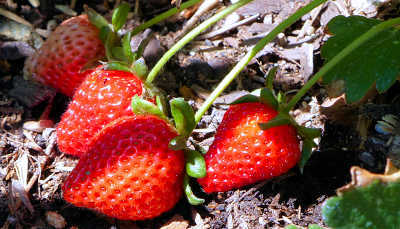Growing Strawberries
FOOD PLANTS
Culinary Herbs
Fruit, Berries, Nuts
Peppers, Chilies
Strawberries
Tomatoes
Vegetable Calendar Zone 9
ORNAMENTALS
Grasses
Ground Cover
Perennials
Shrubs
Succulents
Trees and Palms
Vines
SPECIALTY GARDENS
Butterfly Garden
Erosion Control
Fragrance Garden
Hedges, Barriers, Screens
Hummingbird Garden
Long Blooming
Winter-Blooming
GARDENING TIPS
Dealing with Critters
Digging Holes for Plants
Fruit: Selection, Cultivation
Garden Bed: Sterilizing
Landscaping
Microclimates
Parasitic Plants
Plant Placement
Selecting Plants
Soil Prep for Vegetables
USDA Hardiness Zones
Planting, Watering, Shrubs, Trees
NURSERIES / SUPPLIES
Online
Phoenix
Tucson
MEETINGS
Phoenix Meetings
Tucson Meetings
Overview
A member of the Rose family (Rosaceae), the Fragaria genus has more than 20 species commonly known as strawberries. Modern strawberries, Fragaria ananassa, are hybrids of Fragaria virginiana, native to North America, and Fragaria chiloensis, native to the Pacific coasts of North and South America. European species were the original large fruited strawberries sold in markets and some are still grown for local consumption.

Strawberries fall into three categories. June-bearing, which produce March into May in hot climates, have the largest berries and produce one crop at one time. The harvest date varies by 14 days according to cultivar, ranging from 'early-bearing' to 'mid-season' to 'late-bearing'. June-bearing tend to produce the largest total crop by weight and are the commercial crop of choice.
Ever-bearing cultivars produce two crops, one in spring and one in fall. Some
cultivars seem to be a cross between ever-bearing and day-neutral and have the
best characteristics of both.
Day-neutral cultivars have the smallest berries and produce steadily throughout
the fruiting season, but produce less total fruit than June-bearing.
The best reason to grow your own strawberries is that home grown strawberries can taste far better than those in grocery stores. If there were a "Seven Wonders of the Food World" list, some home grown strawberry cultivars, picked when fully ripe, would be one of them.
Plant Description
Roots
Most strawberry roots grow no more than 6" (15cm) deep and do not exceed 12" (30cm)
deep. Root growth is inhibited in high temperatures.
Heat Tolerance
Only a few strawberry cultivars survive temperatures over 100°F (38°C),
even with 50% shade all day.
Most strawberry cultivars will not set fruit over 80°F (27°C), although some will
flower in higher temperatures and set fruit when nighttime temperatures are below
80°F (27°C).
In hot climates, strawberries do best when planted in the fall and harvested
in the spring.
Cold Tolerance
USDA hardiness zones: 3-10, depending on cultivar.
Flowers are damaged by temperatures below 28°F (-2.2°C) and should be protected
by row covers.
Flowers and Fruits
Strawberry flowers are composite flowers having five, white or pale red petals,
and with a conical center composed of many, tiny yellow flowers called florets.
The florets are self-fruitful and do not need another plant for pollination.
The flowers bloom in spring for all types and also summer and fall for everbearing and
day-neutral varieties.
Botanically, the strawberry is not a berry but an enlarged flower stem covered with
seeds. The part we call fruit is the swollen end of the flower stem with red skin and
sweet red and white flesh. The "seeds" on the outside are fruits of the florets and are
really achenes: dry one-seeded fruit that do not open to release the seed inside.
Time until Fruit and Harvest
Strawberries will fruit 4-5 months after planting and produce mature fruit 4-6 weeks
after flowering. Pick berries when they are fully colored, without any pale areas on the
outside. Wait until they are dark red if possible, and leave a bit of stem on the harvested
berry. The flavor is best at dark red. Strawberries do not ripen further after picking.

Strawberry 'Loran' blooming and fruiting when the current afternoon temperature is 101°F (38°C) and the morning temperature was 71°F (21°C).
Cultivation Practices
Plant in the Fall
For hot desert climates, plant in late summer or early fall,
not mid-winter. The roots will grow in the fall and blooming will begin in March
or April for a spring harvest.
Use Well-Draining Containers, Trays or Raised Garden Beds
Containers should be
used without saucers so as to drain better without standing water in the bottom.
Containers should not receive direct sun on their sides to avoid overheating roots.
Hanging baskets can be used providing the soil does not dry out. Raised garden beds
provide better moisture control than flat beds. Some dedicated gardeners use
greenhouses with automatic misting to control high temperatures.
Soil Preparation
Use well drained, high organic soil with a pH of 5.6-6.5
(acidic to slightly acidic). Do not use ordinary desert soil as part of the soil
mixture. Premium potting soil with moisture retention works well. The soil should be
kept moist.
Fertilize
Not required if soil is properly prepared.
Planting Depth
Place root crowns at, or very slightly above, soil level.
Root crown level is important – too high and the plant will dry out.
Too low and root rot will occur.
Do Not Follow Verticillium-susceptible Plants
Avoid planting strawberries in soil where
nightshades (tomato, pepper, peppers, golden berry, eggplant, etc), melons, okra, mint,
blackberries, raspberries and other bramble berries, stone fruits, chrysanthemums,
and roses or other strawberry plants were growing less than five years earlier.
This will prevent sharing common diseases such as Verticillium Wilt which can
linger in soils for many years.

Sun and Shade
When daytime temperatures are routinely over 90°F (32°C), strawberry plants
must be shielded all day with 50% shade cloth and/or lattice.
From Nov 22 to Mar 21, strawberries can be unshaded.
The rest of the year, afternoon shade is needed.
Mulch
With drip irrigation, 1 to 1.5 mil plastic can be placed under
and around plants to keep berries clean and reduce moisture loss during warm
months. If using straw as mulch, take care not to cover leaves. Straw should
not be used as frost protection. Row covers will protect plants from freezing
temperatures and provide more sunlight during the day.
Watering
Daily in the morning. Pale green leaves indicate overwatering.
Small, misshapen berries signify underwatering. Twice a day at the same times
will be necessary when temperatures are over 95°F (35°C).
In the shortest days of the year, from the first of December to mid-January,
watering can be reduced to every other day.
Remove All Runners
Strawberry plants spread themselves by stolons called runners,
above-ground roots with nodes that grow new roots into the soil at intervals
to produce daughter plants (clones). Cut off all runners to keep the plant's
energy devoted to developing roots, leaves and fruit, unless you want more
strawberry plants.
Remove Weeds by Hand
Remove weeds by hand to avoid cutting shallow roots.
Remove dead or dying leaves and stems, as they appear, to avoid fungal diseases.
Rotating Crops
Home gardeners can grow strawberries in long, narrow containers, then simply replace
the soil and sterilize the containers every 2 years.
In raised garden beds, strawberries should be grown for only two years,
then replaced with other crops for five years. Rotation is necessary
to avoid the build-up of microbial diseases that attack strawberries.
Nightshade family crops, like tomatoes or peppers, cannot be used in the rotation
because they share some of the same diseases with strawberries.
Strawberries are heavy feeders that deplete the soil of nutrients. In rotation years
without strawberries, leguminous cover crops like field pea and clovers can be used to
add nitrogen to the soil.
In one experiment, mustard cover crops and broccoli crop residue were plowed into the
soil, just before replanting strawberries, to reduce the possibility of Verticillium Wilt.
This experiment showed a five year rotation could be achieved instead of the normal
seven years.
Pests
Birds, rodents, slugs and snails can be a problem. An enclosure of
1/2" (13mm) wire mesh or netting on top may be necessary.
Good Companions
Plants that help strawberries include legumes such as
beans and alfalfa which put nitrogen into the soil, and plants that attract
bees such as borage. Caraway is also considered beneficial because it attracts
beneficial wasps.
Experiment with Many Cultivars
Trying different cultivars is the best
way to see what grows well in your location with your garden setup.
Strawberry Plant Problems
All Foliage, No Flowers
This can be caused by too much nitrogen in the soil.
Do not use nitrogen-only or high nitrogen fertilizers. Some cultivars, such as
Quinault, will fail to flower if the soil is not to their liking,
even when other cultivars, like Loran or Sequoia, flower in abundance.
The soil must be properly acidic, have the right balance of
nitrogen, potassium and phosphorous, and not be depleted of nutrients.
Many Flowers, No Fruit
Flowers will not set fruit if temperatures are too high.
For some temperature-sensitive cultivars, daytime temps over 80°F (27°C) will
stop setting fruit even when nighttime temperatures are much lower.
For other cultivars, low nighttime temperatures will keep them setting fruit.
Fruit Ripen Too Small
Insufficient soil nutrients or insufficient water
may cause small fruit. Know what the normal size of the berries
on your cultivar of plant are supposed to be.
Fruit are Brown and Shrunken
Insufficient water caused by (1) temperatures over 85-90°F (29-32°C) and
failure to water twice a day, or (2) plants possibly too close together and competing
for water.
Fruit are Deformed - Phyllody
With this rare disease, floral parts are converted to leaves. The fruit have leaves
growing out of them, green bumps in place of seeds, and/or tips that have turned bumpy
brown. The non-infectious variety is caused by excessive chilling of transplants
in storage. This will disappear over the season.
The infectious variety is caused by phytoplasmas, bacteria-like organisms that harm
plants and are spread by leafhoppers. These plants will continue to produce deformed
fruit and should be destroyed.
Spider Mites
Use a mite predator, such as Phytoseiulus persimilis, which can
be purchased at garden supply companies specializing in organic controls.
Yellow or Red Leaves
Sometimes older leaves on a strawberry plant will die,
and they turn yellow and red in the process because they contain red pigment.
Remove dead and dying leaves as soon as possible to prevent fungal problems.
Red Stele root rot can also cause yellow or red leaves.
This fungal disease is caused by poorly draining soil or overly wet soil. If
your garden bed drains well, yellow and red leaves are usually normal.
Red stems are a characteristic of some cultivars and are not a problem
by themselves.
Brown Leaves
Verticillium Wilt is a root and crown disease that causes
browning along the margins and veins of a leaf. Do not allow soil to dry
completely, and do not place plants where this disease might be present.
Remove dying leaves as soon as possible.
Do you have additional information or a different experience for these plants that you would like to share? Email info@GardenOracle.com. All contributions are welcome and appreciated.
Latest update: May, 2025
© 2008-2025 by GardenOracle.com

